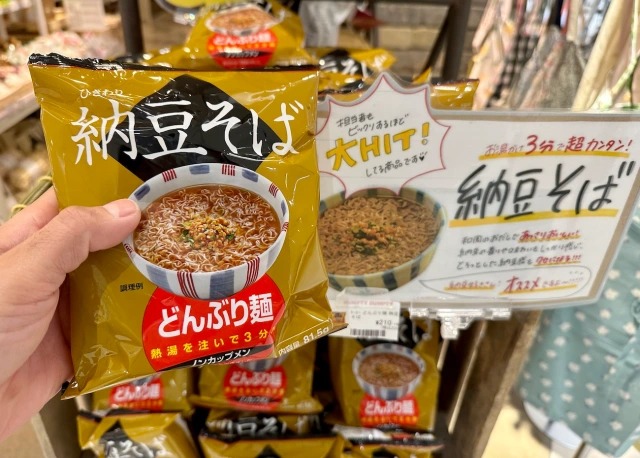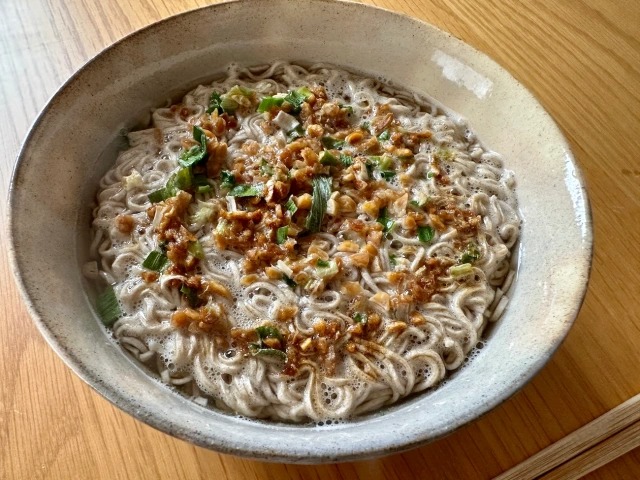
Is Natto Soba natto what it seems?
While out doing his daily shopping, our reporter Masanuki Sunakoma spotted something interesting at his local grocery store. This product called Natto Soba was prominently displayed and labeled as a “Hot Item” and “Big Hit,” which Masanuki found rather strange.
It’s not because Masanuki has any bias against the smelly fermented soybeans called “natto.” He was surprised because despite it being such a top seller the appeared to be no shortage of it in stock. Wondering if maybe he just caught it at a fresh shipment our reporter googled “Natto Soba” and didn’t get much, suggesting it wasn’t really a trending topic online either.
Nevertheless, at this point it was Masanuki’s moral obligation to try some of this suspicious stuff and see what all the fuss — manufactured or otherwise — was about. While grabbing a pack from the overflowing pile and heading to the checkout, our reporter scoped out all the other customers in the store, but nobody else had the “hot item” Natto Soba in their basket.
Feeling he might have been duped, he meekly paid 226 yen (US$1.72) and quickly tucked his noodles into his bag. It wasn’t until he got home that he examined the package, which said this was a product of Toei Foods in Seki City, Gifu Prefecture, home of Japan’s greatest swordsmiths and a pond that looks like something from a Monet painting.
Like any instant noodle pack, Natto Soba was super easy to prepare. First, Masanuki put the dried noodles into a bowl. Then, he added the seasoning which included dried natto.
Next, he boiled some water and poured it all over the dried components.
Right away, the distinct smell of natto billowed out and all the tiny beans seemed to rehydrate to all of their slimy glory.
Masanuki didn’t mind the smell because he associates it with health and vitality, but he had to cover the bowl for the next three minutes to lock in the heat as is the norm for instant noodles.
Three minutes later, his “big hit” meal was ready!
Looking at the finished product, Masanuki realized he had never actually had natto and soba together before. It’s not a common combination in Japanese cuisine, so do they even go together?
Not only did natto and soba go together, but they went together even better than he imagined they could. The seasoning of the broth was the perfect match for that unmistakable natto taste.
And the curly soba noodles were excellent at catching and locking in the beans and other ingredients so that each bite had a sense of balance and harmony. That smell from when the hot water was poured had died down considerably too and after a few bites there pretty much wasn’t any smell to speak of.
Part of the reason it tasted so good might have had to do with the absence of any artificial flavors in the seasoning. If our reporter had to find one flaw with Natto Soba, it’s that it might not be natto-y enough to satisfy natto maniacs, but it’s sure to give natto moderates and those merely tolerant to natto a pleasant surprise.
Whether this really is a “big hit” or “hot item” still isn’t clear, but as far as Masanuki is concerned it ought to be.
Photos ©SoraNews24
● Want to hear about SoraNews24’s latest articles as soon as they’re published? Follow us on Facebook and Twitter!
[ Read in Japanese ]











 Instant noodle company combines yakisoba noodles with fermented natto bean topping
Instant noodle company combines yakisoba noodles with fermented natto bean topping Which noodles, other than Okinawa soba, pair best with Okinawa soba broth?【Taste Test】
Which noodles, other than Okinawa soba, pair best with Okinawa soba broth?【Taste Test】 We spice up our fermented soybeans with curry powder flavored natto【Taste Test】
We spice up our fermented soybeans with curry powder flavored natto【Taste Test】 Natto-infused ramen is a thing — we tried it, we love it【Taste test】
Natto-infused ramen is a thing — we tried it, we love it【Taste test】 Powering up our instant noodles with Nissin Cup Noodle’s instant tempura and abura-age【Taste Test】
Powering up our instant noodles with Nissin Cup Noodle’s instant tempura and abura-age【Taste Test】 Dragon Quest Burgers and Slime drinks are coming to McDonald’s Japan【Video】
Dragon Quest Burgers and Slime drinks are coming to McDonald’s Japan【Video】 Disillusionment at Tsukiji’s tourist-target prices led us to a great ramen restaurant in Tokyo
Disillusionment at Tsukiji’s tourist-target prices led us to a great ramen restaurant in Tokyo Oh Boy, That’s Pretty Racist (Part Two): Japanese woman explains why Taiwanese girls suck
Oh Boy, That’s Pretty Racist (Part Two): Japanese woman explains why Taiwanese girls suck As fan art pops up for anime-style English textbook character, original artist asks for restraint
As fan art pops up for anime-style English textbook character, original artist asks for restraint Dragon Quest Slime toys appear at McDonald’s Japan in crossover with Grimace and pals【Video】
Dragon Quest Slime toys appear at McDonald’s Japan in crossover with Grimace and pals【Video】 East Japan Railway abolishes skirts, ribbons in women’s uniforms to “eliminate gender difference”
East Japan Railway abolishes skirts, ribbons in women’s uniforms to “eliminate gender difference” Lacquerware supplier to emperor of Japan and Pokémon team up for new tableware
Lacquerware supplier to emperor of Japan and Pokémon team up for new tableware We visit the full-scale Evangelion statue in Kyoto and particularly delight in the food tie-ins
We visit the full-scale Evangelion statue in Kyoto and particularly delight in the food tie-ins Is it rude to sing along at concerts in Japan? We ask a pro musician for his take
Is it rude to sing along at concerts in Japan? We ask a pro musician for his take Digital resurrection after death? 63 percent of Japanese and American survey participants say nah
Digital resurrection after death? 63 percent of Japanese and American survey participants say nah 7-Eleven Japan starts new temporary luggage storage service in over 300 branches
7-Eleven Japan starts new temporary luggage storage service in over 300 branches Starbucks teams up with 166-year-old Kyoto doll maker for Year of the Horse decorations【Photos】
Starbucks teams up with 166-year-old Kyoto doll maker for Year of the Horse decorations【Photos】 Japan may add Japanese language proficiency, lifestyle classes to permanent foreign resident requirements
Japan may add Japanese language proficiency, lifestyle classes to permanent foreign resident requirements Starbucks Japan releases new zodiac chilled cup drink for 2026
Starbucks Japan releases new zodiac chilled cup drink for 2026 Tokyo’s Tsukiji sushi neighborhood asks tour groups to stay away for the rest of the month
Tokyo’s Tsukiji sushi neighborhood asks tour groups to stay away for the rest of the month Is this the most relaxing Starbucks in Japan?
Is this the most relaxing Starbucks in Japan? Starbucks on a Shinkansen bullet train platform: 6 tips for using the automated store in Japan
Starbucks on a Shinkansen bullet train platform: 6 tips for using the automated store in Japan Street Fighter Hadouken Churros to be launched and eaten in Tokyo, Okami pudding on offer too
Street Fighter Hadouken Churros to be launched and eaten in Tokyo, Okami pudding on offer too Japan’s human washing machines will go on sale to general public, demos to be held in Tokyo
Japan’s human washing machines will go on sale to general public, demos to be held in Tokyo Japanese train company is letting fans buy its actual ticket gates for their homes
Japanese train company is letting fans buy its actual ticket gates for their homes Tokyo considering law requiring more trash cans following litter increase in heavily touristed area
Tokyo considering law requiring more trash cans following litter increase in heavily touristed area Nintendo’s Kirby now delivering orders at Kura Sushi restaurants, but not in Japan
Nintendo’s Kirby now delivering orders at Kura Sushi restaurants, but not in Japan Tokyo event lets you travel back in time, for free, to celebrate 100 years since Showa era start
Tokyo event lets you travel back in time, for free, to celebrate 100 years since Showa era start Sanrio theme park in Japan announces plans to expand into a Sanrio resort
Sanrio theme park in Japan announces plans to expand into a Sanrio resort Survey asks foreign tourists what bothered them in Japan, more than half gave same answer
Survey asks foreign tourists what bothered them in Japan, more than half gave same answer Japan’s deadliest food claims more victims, but why do people keep eating it for New Year’s?
Japan’s deadliest food claims more victims, but why do people keep eating it for New Year’s? We deeply regret going into this tunnel on our walk in the mountains of Japan
We deeply regret going into this tunnel on our walk in the mountains of Japan Studio Ghibli releases Kodama forest spirits from Princess Mononoke to light up your home
Studio Ghibli releases Kodama forest spirits from Princess Mononoke to light up your home Major Japanese hotel chain says reservations via overseas booking sites may not be valid
Major Japanese hotel chain says reservations via overseas booking sites may not be valid Put sesame oil in your coffee? Japanese maker says it’s the best way to start your day【Taste test】
Put sesame oil in your coffee? Japanese maker says it’s the best way to start your day【Taste test】 The top 10 annoying foreign tourist behaviors on trains, as chosen by Japanese people【Survey】
The top 10 annoying foreign tourist behaviors on trains, as chosen by Japanese people【Survey】 No more using real katana for tourism activities, Japan’s National Police Agency says
No more using real katana for tourism activities, Japan’s National Police Agency says Starbucks Japan reveals new sakura drinkware collection, inspired by evening cherry blossoms
Starbucks Japan reveals new sakura drinkware collection, inspired by evening cherry blossoms Hey, have you eaten the news? – Japanese “noodle newspaper” comes with writing on the soba
Hey, have you eaten the news? – Japanese “noodle newspaper” comes with writing on the soba We try cooking yakisoba with real Japanese buckwheat soba【SoraKitchen】
We try cooking yakisoba with real Japanese buckwheat soba【SoraKitchen】 Still using water to make your instant noodles? You’re missing out on amazing green tea noodles!
Still using water to make your instant noodles? You’re missing out on amazing green tea noodles! Japan’s first made-to-order natto store will make you fermented beans without the putrid smell
Japan’s first made-to-order natto store will make you fermented beans without the putrid smell Kakiage towers and Italian soba? We try out a unique soba restaurant in Tokyo
Kakiage towers and Italian soba? We try out a unique soba restaurant in Tokyo Should you add instant ramen toppings before or after adding hot water?【Taste test】
Should you add instant ramen toppings before or after adding hot water?【Taste test】 Marvelous Soba: Colour-changing noodle broth creates a twist ending to your meal
Marvelous Soba: Colour-changing noodle broth creates a twist ending to your meal Cup Noodles Breakfast: a curse against instant ramen or the best thing since sliced bread?
Cup Noodles Breakfast: a curse against instant ramen or the best thing since sliced bread? A whole new way to eat katsu: Cold katsu soba【Taste test】
A whole new way to eat katsu: Cold katsu soba【Taste test】 Starbucks adds Japanese soba noodles to its menu…in Hong Kong?!?【Taste test】
Starbucks adds Japanese soba noodles to its menu…in Hong Kong?!?【Taste test】 We eat at the legendary Negidon, a Tokyo soba restaurant that’s only open for lunch on weekdays
We eat at the legendary Negidon, a Tokyo soba restaurant that’s only open for lunch on weekdays Japan Super Budget Dining – What’s the best way to spend 1,000 yen at Fuji Soba?
Japan Super Budget Dining – What’s the best way to spend 1,000 yen at Fuji Soba? Osaka street food becomes a Tokyo noodle topping with the Deluxe Takoyaki Soba【Taste test】
Osaka street food becomes a Tokyo noodle topping with the Deluxe Takoyaki Soba【Taste test】 Koto is a local favorite in Iruma, Saitama, for its large food portions, so we check it out
Koto is a local favorite in Iruma, Saitama, for its large food portions, so we check it out We go looking for the best natto (fermented soybeans) in all of Japan【Taste test】
We go looking for the best natto (fermented soybeans) in all of Japan【Taste test】 The most expensive natto in Japan – Eating the “black diamonds” of Tanba Kuro【Taste test】
The most expensive natto in Japan – Eating the “black diamonds” of Tanba Kuro【Taste test】
Leave a Reply